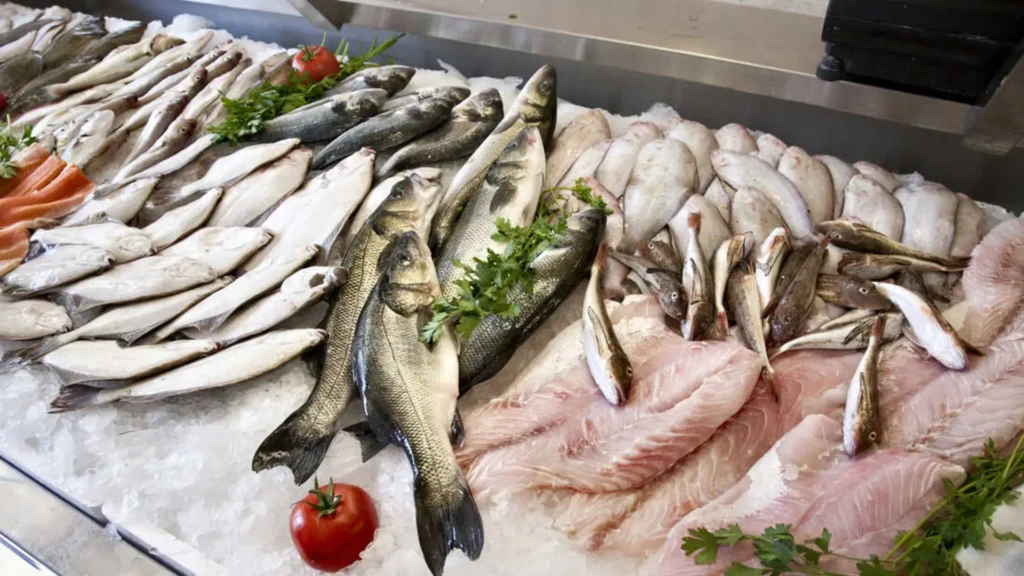When you’re navigating the bustling aisles of your local fish market, the key to hauling in the freshest catch isn’t just about getting there early; it’s about knowing exactly what to look for and where. You’ll want to check the fish for vibrant, clear eyes and glistening skin—a dull appearance often signals a less-than-fresh choice. But there’s more to it than just the visuals. Engaging with the vendors, understanding the significance of labels like ‘wild-caught’ versus ‘farm-raised,’ and recognizing sustainability seals can dramatically elevate your seafood selection game. Stick around, as I’m about to reveal how these nuances can transform your next seafood purchase from adequate to outstanding.
Identifying Fresh Fish and Shellfish
When selecting fresh fish and shellfish, you should first check for bright, clear eyes and firm, shiny flesh as indicators of freshness. Dull or cloudy eyes often suggest the fish isn’t at its peak freshness. Additionally, the gills should be a rich red or pink, not brown or slimy. If you’re allowed, gently press the flesh; it should spring back rather than leaving an indent, which indicates the fish might be past its prime.
For shellfish, ensure that shells are tightly closed or close when tapped. If they remain open, it’s likely they’re no longer alive and should be avoided. With shucked shellfish, like scallops or oysters, look for a moist, not dry or overly slimy appearance. The smell is also a crucial factor; fresh seafood should smell like the ocean, clean and briny, not fishy or ammonia-like.
Don’t hesitate to ask the fishmonger about the catch of the day. They can provide valuable insights into what’s most fresh or offer tips on the best ways to prepare different types of seafood. Remember, fresh seafood shouldn’t just look good but should also smell fresh and feel right to the touch.
Deciphering Market Labels
Understanding market labels can greatly enhance your ability to select the freshest and most sustainable seafood options available. When you’re at the market, you’ll encounter a variety of labels, and knowing what they mean is crucial.
Labels like ‘wild-caught’ and ‘farm-raised’ tell you about the origins of the seafood. Wild-caught means the fish was caught in its natural habitat, which often leads to a better flavor and texture. However, it’s important to ensure that it’s sourced sustainably to protect wildlife populations.
On the other hand, farm-raised indicates the seafood was grown in controlled environments, which can be more sustainable but varies greatly in quality depending on the farming practices.
Look for sustainability certifications such as MSC (Marine Stewardship Council) or ASC (Aquaculture Stewardship Council). These certifications mean that the seafood meets specific standards for environmental sustainability and responsible fishing or farming practices.
Don’t overlook labels indicating freshness or processing like ‘previously frozen’ or ‘fresh.’ If it says ‘previously frozen,’ the seafood was frozen soon after being caught, which can preserve its quality until thawing for sale. Understanding these labels helps you make informed choices about both quality and environmental impact.
Mastering Price Negotiation
Now that you’re familiar with market labels, let’s explore how you can negotiate the best prices for the freshest seafood. Mastering price negotiation at your local fish market isn’t just about haggling; it’s about understanding the value and timing your purchase right.
Firstly, always visit the market early or late in the day. Sellers are more likely to lower prices when they’re setting up or about to close. This is when you’ll find deals on the freshest catches that haven’t been sold yet.
Get to know your vendors. Building a rapport with sellers can lead to better prices. They’re more willing to cut a deal if they see you as a regular who appreciates their goods. Plus, they can offer invaluable advice on what’s best to buy when.
Don’t be afraid to ask for a better price, especially if you’re buying in bulk. Vendors expect some negotiation and might have a little wiggle room in their pricing, especially if it means making a larger sale.
Lastly, observe the market. If seafood isn’t moving, vendors might be willing to negotiate rather than risk having to throw it out. Use this knowledge to your advantage, and don’t hesitate to walk away if the deal doesn’t feel right.
Now you’re equipped to navigate your local fish market like a pro. Remember, spotting fresh seafood means checking for bright eyes, firm flesh, and vibrant gills. Understand the labels—wild-caught often promises natural flavors, while farm-raised ensures steady supply. Don’t shy away from negotiating; being friendly yet firm can snag you the best deal.
With these expert tips, you’ll not only save money but also bring home the freshest, most sustainable seafood for your table.
Learn more:
How to Navigate the Sea of Choices at Your Neighborhood Fish Market

